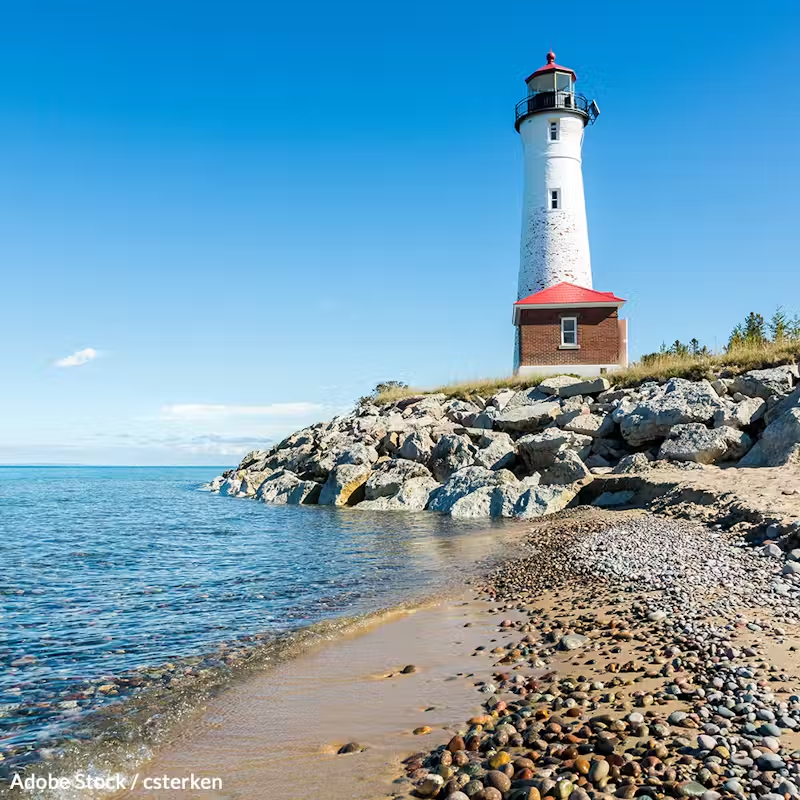Protect Our Largest Source of Fresh Drinking Water
9,442 signatures toward our 50,000 Goal
Sponsor: The Rainforest Site
The Great Lakes make up 90% of North America's fresh surface water and are threatened by pollution and climate change.

Forty million people rely on the Great Lakes for drinking water, but much of that water infrastructure is old and crumbling. Pollution and climate change meanwhile threaten this vital source of freshwater with toxic chemical pollution and algal blooms.
The federal government used to cover about 63% of the costs for clean water infrastructure. That share has now dropped to 9%, with the resulting burden hitting hardest on low-income and minority communities1.
Only about 1% of the water in the Great Lakes leaves the basin each year, through the St. Lawrence River. This means the pollutants that are dumped into the Great Lakes remain there, and become concentrated over time. And there are a substantial number of pollutants that threaten the lakes2. Lead pipes, harmful algal blooms or PFAS toxins in the water can lead to serious health issues in communities living nearby3.
Today, an estimated 88% of Great Lakes residents support and are willing to pay for Great Lakes restoration4. A 2018 poll found that more than half of the people who responded feel that regulation of the Great Lakes is lacking and said they would be willing to to pay for increased regulation through higher prices for products4.
The Healing Our Waters-Great Lakes Coalition, representing hundreds of Great Lakes environmental groups, has written a letter to Congress demanding prioritization of the health and safety of the Great Lakes and the drinking water it provides to over 40 million Americans as part of federal government investments to recover from the devastating Coronavirus pandemic5.
These stimulus funds could be used to repair aging water infrastructure and support Great Lakes restoration activities that protect source water, as well as prevent water shut-offs.
Investments would modernize outdated water infrastructure to protect drinking water and public health; help communities respond to high lake levels and climate impacts; strengthen the Great Lakes navigation system; and accelerate funding for cleanup projects that will spur economic development, while sustaining efforts to block the introduction of Asian carp and implement agricultural conservation practices to prevent harmful algal blooms6.
At minimum, the upkeep and maintenance of our Great Lakes requires an investment of $20 billion each year over the next five years, and the potential stimulus package is a vehicle to fill this need.
Sign the petition below and demand our leaders take a stand for fresh drinking water and increase funding to the Great Lakes.
- Clean Water Action, (2021), "Water Infrastructure in the Great Lakes: Turning the "Rust Belt" into the "Water Belt"."
- Safe Drinking Water Foundation, "The Great Lakes."
- Hannah Mico, River Network (1 February 2021), "Protecting Drinking Water in the Great Lakes."
- Gary Wilson, Great Lakes Now (10 July 2018), "Public wants protection for the Great Lakes, poll reveals."
- Great Lakes Commission, Great Lakes Fishery Commission, Healing Our Waters-Great Lakes Coalition, Great Lakes and St. Lawrence Cities Initiative, Chippewa Ottawa Resource Authority, American Great Lakes Ports Association, Great Lakes Metro Chambers Coalition, Great Lakes-St. Lawrence Legislative Caucus and BlueGreen Alliance, "Letter to Congress."
- Great Lakes Commission des Grands Lacs (12 May 2020), "Great Lakes organizations urge Congress to include Great Lakes investments in stimulus funding."
The Petition:
Dear ranking members of the United States Senate and House of Representatives Committee on Appropriations,
The Great Lakes are the biggest source of freshwater in North America, supplying drinking water to 40 million Americans, and millions more of our neighbors to the North.
As our aging infrastructure begins to crumble, toxic pollution is dumped into the lakes, and climate change hastens problematic phenomena like algal blooms, the health of those millions is at risk.
Pollutants that are dumped into the Great Lakes remain there for years, and become concentrated over time. Toxins leeched from lead pipes, harmful algal blooms or PFAS chemicals in the water can and have had devastating effects on communities who drink this water. The people of Flint, Michigan, are still reeling from lead poisoning and Legionnaire's disease after the state government underestimated the implications of an aging water system.
The Great Lakes water system needs an investment to repair crumbling and ineffective infrastructure and support Great Lakes restoration activities that protect source water, as well as prevent water shut-offs.
This investment will modernize outdated water infrastructure to protect drinking water and public health; help communities respond to high lake levels and climate impacts; strengthen the Great Lakes navigation system; and accelerate funding for the Great Lakes Restoration Initiative to implement ready to launch cleanup projects that will spur economic development in coastal communities, while sustaining efforts to block the introduction of Asian carp and implement agricultural conservation practices to prevent harmful algal blooms.
At minimum, the upkeep and maintenance of our Great Lakes requires an investment of $20 billion each year over the next five years, and the potential stimulus package is the perfect vehicle to fill this need.
I demand you support this investment into the largest source of fresh drinking water we have in the United States, and protect our Great Lakes.
Sincerely,